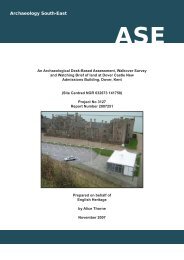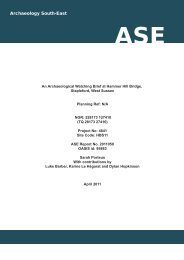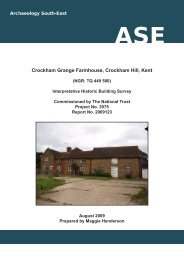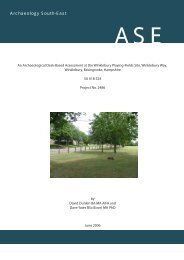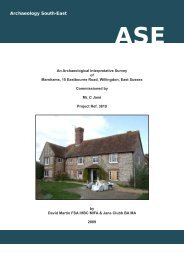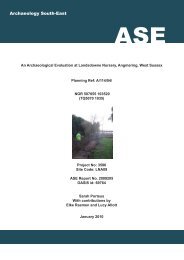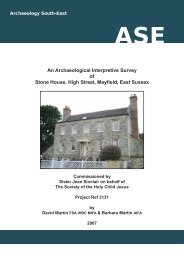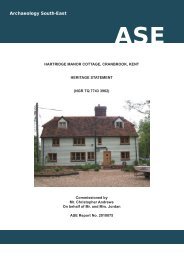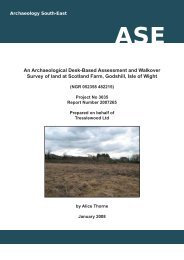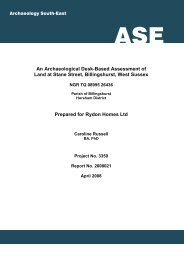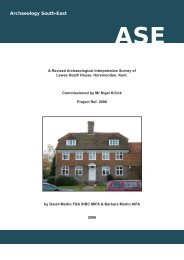ASE front cover - Archaeology South-East
ASE front cover - Archaeology South-East
ASE front cover - Archaeology South-East
You also want an ePaper? Increase the reach of your titles
YUMPU automatically turns print PDFs into web optimized ePapers that Google loves.
<strong>Archaeology</strong> <strong>South</strong>-<strong>East</strong>2008058: Holbury Infants School, Holbury, Hampshire5.1.1.1 In total 1194 sherds of Roman pottery, weighing 18.32 kg and amounting to14.5 EVEs, were excavated from the site. The pottery groups all fall within afairly narrow time period between the late 3 rd to early/mid 4 th centuries.Despite a small but consistent quantity of probably residual 2 nd and 3 rdcentury material there is little evidence for stratified assemblages of thisdate. Furthermore the 2 nd century samian, which makes up the majority ofthe residual material, is all notably abraded in comparison to the bulk of theassemblage which generally consists of quite fresh, fairly large sherds. Theearlier material re<strong>cover</strong>ed could be explained by the presence of a earlyRoman Road in the vicinity of the site, with the 2 nd and 3 rd century materialrelating to the construction and initial use of the road prior to moredeveloped settlement and activity on the site.5.1.1.2 The pottery was examined using a x20 binocular microscope and quantifiedby sherd count, weight and EVEs. In the absence of a regional type seriesfor Hampshire, fabrics, forms and decoration were recoded using Museumof London codes and, where possible, cross-referenced to the NationalRoman Fabric Reference Collection (Tomber & Dore 1998; Table 2). Sitespecificcodes are marked * and described in the text.Code Expansion ConcordanceAHFA Alice Holt/ Farnham ware ALH REAHSUAlice Holt/ Surrey wareAMPHUnsourced amphoraBAETE Baetican Dressel 20/ Haltern 70 amphora fabric BAT AM 1BB1 Black-burnished ware 1 DOR BB 1BBSBlack-burnished style wareCCUnsourced colour-coated waresCGBL Central Gaulish black-slipped ware CNG BSFL1*Flint-tempered wares (residual prehistoric)GAUL1 Pelichet 47/Dressel 30 amphora fabric GAL AM 1GROG1* Late Roman grog-tempered ware HAM GTGROG2*Late Roman grog-tempered ware (coarse oxidised variant)NFCC New Forest colour-coated ware NFO CCNFRC New Forest red-slipped ware NFO RS 2NFRCC New Forest red-slipped ware (coarse variant) NFO RS 1?NFWW New Forest white ware NFO WH 1NVCC Nene Valley colour coated ware LNV CCOXIDUnsourced oxidised waresOXIDFUnsourced fine oxidised waresPORD Portchester ware D OVW WHRCGWRowland’s castle greywareSAMCG Central Gaulish samian ware LEZ SA 2SAMCG/EG Central or <strong>East</strong> Gaulish samian LEZ SA 2/ HGB SASANDUnsourced greywaresV1* Organic tempered wares (residual prehistoric)Table 2: Fabric codes with concordances to Tomber & Dore (1998)5.1.2 Fabric & Form Types5.1.2.1 The most striking aspect of the assemblage is the predominance of grogtemperedfabrics which make up nearly half of the assemblage. Themajority is GROG1, a hand-made fabric with dark, often lustrous burnishedsurfaces. The grog is multicoloured and usually in the 1-2mm size range.The matrix also contains common fine quartz mostly around 0.1mm or less.This fabric is of the same type as Portchester hand-made fabric A (Fulford1975a, 286), produced from around AD 270 until the end of the Romanperiod. The north of the Isle of Wight has been identified as one of thesources of this ware although others may exist on the mainland (Lyne2007). The associated forms are nearly all black-burnished ware styleeverted or cavetto rim jars, bead and flange bowls and plain rim dishes. The18© <strong>Archaeology</strong> <strong>South</strong>-<strong>East</strong>



